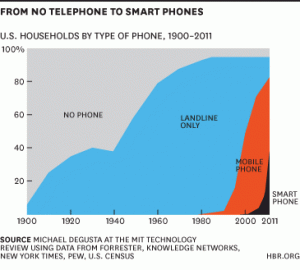The age-old question of the fastest way to share information remains relevant even in 2014. For centuries, people have sought to improve the speed of communication. In recent times, email has been the quickest way to send written messages. However, the issue with email today is that it can be too easy to just hit send. Mashable reported that in 2013, over 144 billion emails (89 billion for business and 55 billion for personal use) were sent each day.
That data is ironic, because according to a New York Times article by Nick Bilton, he states, “‘studies have shown that all this email leads to an unproductive and anxiety-ridden workplace’”, said Gloria Mark, an informatics professor at the University of California, Irvine. To further this point, Bilton cites Clive Thompson, author of, Smarter Than You Think: How Technology is Changing Our Minds for the Better by stating “that in the workplace, email had become a major barrier of efficiency. ‘People feel the need to include 10 other people on an email just to let them know they are being productive at work,’ he said. ‘But as a result, it ends up making those other 10 people unproductive because they have to manage that email.’”
The real danger in these findings is two-fold; first, office-bound employees reliant on email communications are unproductive and second, the ever-growing mobile workforce who doesn’t use email, because their workflow isn’t conducive to it, are left behind. This results in an extremely unproductive team that doesn’t have the best means of communication. Email solved the original problems of communication, fast and instant communication, but it is now being usurped by new mobile business communication apps due to the pervasive nature of smartphones. Companies that are not promoting communication this way may be leap-frogged by those that are. To support this, Michael DeGusta of MIT’s Technology Review,:
 shows just how quickly mobile technology is persisting in our society. He states that “it took 30 years for electricity and 25 years for telephones to reach 10% adoption but less than five years for tablet devices to achieve the 10% rate. It took an additional 39 years for telephones to reach 40% penetration and another 15 before they became ubiquitous. Smart phones, on the other hand, accomplished a 40% penetration rate in just 10 years…”
shows just how quickly mobile technology is persisting in our society. He states that “it took 30 years for electricity and 25 years for telephones to reach 10% adoption but less than five years for tablet devices to achieve the 10% rate. It took an additional 39 years for telephones to reach 40% penetration and another 15 before they became ubiquitous. Smart phones, on the other hand, accomplished a 40% penetration rate in just 10 years…”
This powerful information suggests that mobile workers now have a device that is better suited to their workflow, and will enable the kind of leaps in productivity previously limited to those working from a desktop device.
So how will you ensure that all of your workers are working in an age of increasing mobility and email clutter? Read on about The New Mobile Business Communication Landscape to learn how.